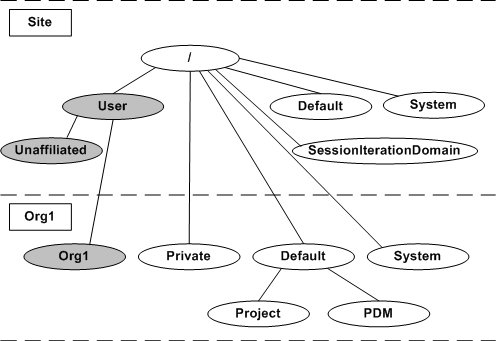Your Installed Windchill Environment
Your installed Windchill environment consists of a set of containers that hold all of the administrative areas (known as domains), rules, and data that make up the context from which Windchill users work.
The containers are set up in a hierarchy that is described in
Working With the Initial Organization Context.
Within the installed containers, a set of domains are loaded during the installation process. For example, the site and Org1 contexts have the domains shown in following diagram:
In the diagram, the dashed line shows the container boundaries and the domain inheritance is shown by the lines connecting the domains. The top-level domain is labeled / (root) and is in the site context. The shaded domains are the domains associated with Windchill participants (users, user-defined groups, and organizations).
After containers are created and users become team members, the framework established is called the context from which the users work. In many instances, the context includes the contents of a specific container and the domains, rules, and data available from ancestor containers. For example, if a user entering Windchill ProjectLink navigates to a folder within the Bike Design project and creates a new document, that document is managed in the context of the Bike Design project. Persons with access to the Bike Design project may automatically have the right to see and modify the new document.
Depending on how container rules are set up, users may also be able to share data across containers. When this is the case, the user context can include data from multiple containers. You can think of the context as providing the framework from which user actions are executed. This framework is defined by a container, but can include data from multiple containers. For example, parts defined in one container can be used in an assembly structure that is saved in a different container.
Throughout the user interface, Context is used to identify where in the framework specific rules, domains, and data reside. Since Context is the label you see in the interface, the remainder of this guide uses the term context (rather than container) when referring to the framework that is in place. Each context provides the following:
• The context structure, which includes the default domains and folders, discussion forum topics, reference notebook folders, and user notebook folders (if used).
• Context participation, which includes the available roles, teams, and system groups.
• Default access policies.
• Data types and object initialization rules.
• Preferences established for the specific context.
• Default life cycle, workflow, context, team, and report templates.
The base data that is loaded during the installation process creates the out-of-the-box templates for contexts, workflows, life cycles, teams, and reports, and associates them with the System domain that is in the site context. These templates are then available to descendent contexts where appropriate.
The Administrator user and the Administrators group are created during the base installation and are also associated with the System domain. Out of the box, these administrators have full access control over all Windchill objects.
One important type of data that is loaded is the context template data. Context template data files are XML files that define what is initially in a context when it is created. The file contains the types of items that are similar to the type of data, rules, and domains that are loaded during the
Windchill solution installation. When creating additional contexts, the administrator selects the context template data file to use to establish the context. For more information on context templates, see
Creating the Contexts from which Users Work
